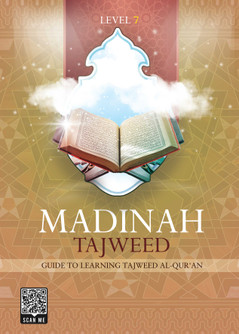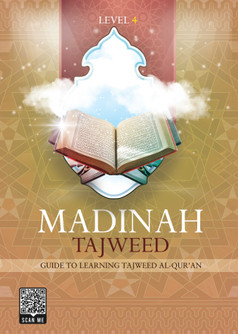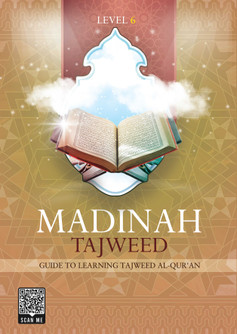
Tajweed Rules for Adults Book 5
By Manarah Publishing
Introduction – Part Five: Tajweed Series for Adults
All praise is due to Allah, who revealed the Qur’an in perfect balance, with clarity in sound and harmony in meaning. Every letter, every pause, and every rhythm in the Qur’an has been preserved with divine precision. May peace and blessings be upon the final Messenger, Muhammad ﷺ, who recited the Qur’an exactly as it was revealed, and taught it to his companions with patience, wisdom, and care. Our mother ʿĀ’ishah, may Allah be pleased with her, said: “His character was the Qur’an.”
We are pleased to present Part Five of the Tajweed Series for Adults. In this part, we move beyond the foundational pronunciation rules and begin exploring the character and of letters—how they sound, how they interact, and how they affect the beauty and flow of Qur’anic recitation.
This book is divided into three core units, each covering an important area of advanced tajweed:
Unit One: The Characteristics of the Letters (Ṣifāt Al-Ḥurūf)
In this unit, students will learn how each Arabic letter has special features that make it unique. These are called the ṣifāt (characteristics). This includes:
⦁ The Accent in Recitation
⦁ Characteristics That Have Opposites:
Characteristics Without Opposites: Other Important Traits
Unit Two: Heaviness and Lightness (At-Tafkhīm wa At-Tarqīq)
This unit focuses on how some letters are pronounced heavily and others lightly. This is an essential skill in tajweed, especially in preserving the meaning and sound of the Qur’an. Topics include:
⦁ Letters Always Pronounced with Heaviness
⦁ Letters Always Pronounced with Lightness
Letters That Can Be Pronounced Either Way,
Unit Three: The Relationship Between Meeting Letters
In this advanced unit, students explore how two letters affect each other when they appear side by side. This includes:
⦁ Al-Mutamāthilān (Identical Letters)
⦁ Al-Mutajānisān (Similar Letters)
⦁ Al-Mutaqāribān (Close Letters)
⦁ Al-Mutabāʿidān (Distant Letters)
⦁ Preventing Two Sakins
Each section in this book includes step-by-step explanations, recitation tips, and examples directly from the Qur’an. This part of the series is ideal for students who wish to master the deeper details of tajweed and beautify their recitation even further.
May Allah reward your efforts in learning His Book, and may He make the Qur’an a light in your heart, a companion in your life, and an intercessor on the Day of Judgment.
$19.99
- SKU:
- CB-SCL-QRLRN-004606
- Gift wrapping:
- Options available
- Publisher:
- Manarah
- ISBN:
- 978-1-947432-11-6
- Format:
- Paperback
- Language:
- English
- Age Range:
- Adults (13 Years old and over)
- Grade Level:
- Adults (13 Years old and over)
Introduction – Part Five: Tajweed Series for Adults
All praise is due to Allah, who revealed the Qur’an in perfect balance, with clarity in sound and harmony in meaning. Every letter, every pause, and every rhythm in the Qur’an has been preserved with divine precision. May peace and blessings be upon the final Messenger, Muhammad ﷺ, who recited the Qur’an exactly as it was revealed, and taught it to his companions with patience, wisdom, and care. Our mother ʿĀ’ishah, may Allah be pleased with her, said: “His character was the Qur’an.”
We are pleased to present Part Five of the Tajweed Series for Adults. In this part, we move beyond the foundational pronunciation rules and begin exploring the character and of letters—how they sound, how they interact, and how they affect the beauty and flow of Qur’anic recitation.
This book is divided into three core units, each covering an important area of advanced tajweed:
Unit One: The Characteristics of the Letters (Ṣifāt Al-Ḥurūf)
In this unit, students will learn how each Arabic letter has special features that make it unique. These are called the ṣifāt (characteristics). This includes:
⦁ The Accent in Recitation
⦁ Characteristics That Have Opposites:
Characteristics Without Opposites: Other Important Traits
Unit Two: Heaviness and Lightness (At-Tafkhīm wa At-Tarqīq)
This unit focuses on how some letters are pronounced heavily and others lightly. This is an essential skill in tajweed, especially in preserving the meaning and sound of the Qur’an. Topics include:
⦁ Letters Always Pronounced with Heaviness
⦁ Letters Always Pronounced with Lightness
Letters That Can Be Pronounced Either Way,
Unit Three: The Relationship Between Meeting Letters
In this advanced unit, students explore how two letters affect each other when they appear side by side. This includes:
⦁ Al-Mutamāthilān (Identical Letters)
⦁ Al-Mutajānisān (Similar Letters)
⦁ Al-Mutaqāribān (Close Letters)
⦁ Al-Mutabāʿidān (Distant Letters)
⦁ Preventing Two Sakins
Each section in this book includes step-by-step explanations, recitation tips, and examples directly from the Qur’an. This part of the series is ideal for students who wish to master the deeper details of tajweed and beautify their recitation even further.
May Allah reward your efforts in learning His Book, and may He make the Qur’an a light in your heart, a companion in your life, and an intercessor on the Day of Judgment.











